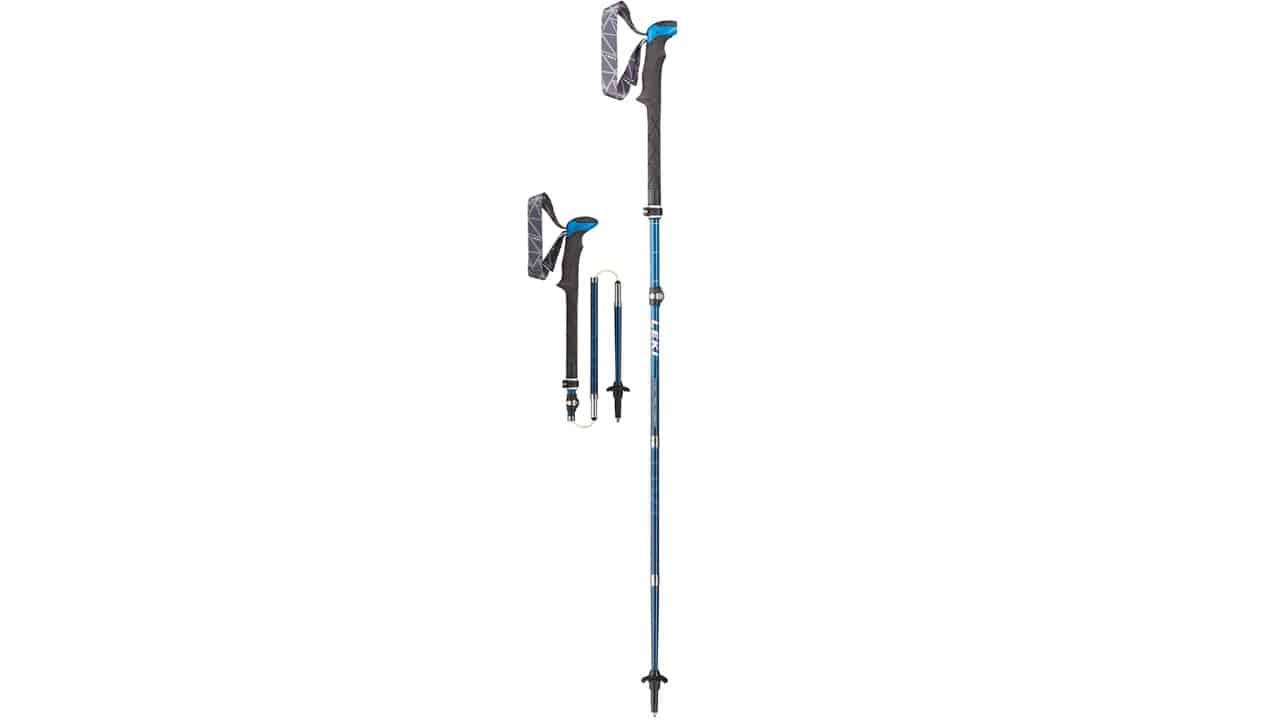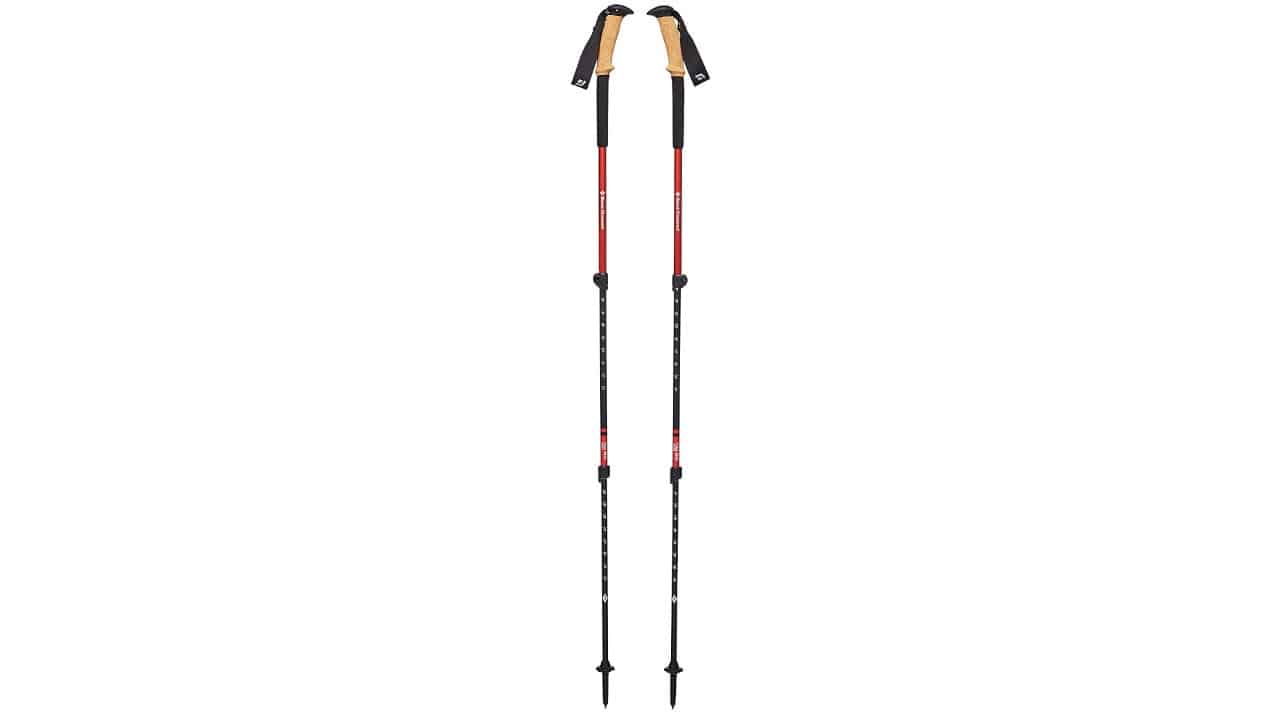Does it matter if your trekking poles are Carbon Fiber or Aluminum? In the simplest of terms, this piece of outdoor gear is just a stick with a wrist strap and a handle. We could even say that a simple wooden stick can serve pretty much the same purpose.
However, using an actual trekking pole instead of a simple wooden stick has several advantages. For example, trekking poles are adjustable – one can easily increase or decrease the length of the hiking pole and thus make it more useful. I have already compiled a list of the best trekking poles.
Trekking poles are typically made out of carbon fiber or aluminum. The primary difference between the carbon fiber and aluminum poles is in durability and weight. In general, carbon fiber trekking poles are lightweight, but they’re less durable. Aluminum trekking poles, on the other hand, are long-lasting but at the same time heavier.
In this article, we’ll be taking a closer look at these and other differences between aluminum and carbon poles. We’ll also analyze the most popular carbon fiber hiking pole, the LEKI Micro Vario, and the most popular aluminum hiking pole, the Black Diamond Trail Ergo.
Carbon Fiber Trekking Poles – Advantages and Disadvantages
In simple terms, carbon fiber is a matrix of crystalline filaments of carbon laid in resin. Obviously, the quality of the carbon fiber poles always depends on the manufacturer.
Nevertheless, most carbon fiber trekking poles have a weight of 12 to 18 ounces per pair. A well-made pair of carbon fiber poles will easily withstand forces coming from top to bottom. However, most of them aren’t that strong when it comes to withstanding side-to-side forces. In case their resin becomes fatigued over time or if their fibers get damaged by abrasion, most carbon fiber poles will break in half.
Advantages
If you get yourself a high-end, (and therefore probably expensive), model, a carbon fiber trekking pole can be exceptionally comfortable to use. They provide users with more immediate support due to the fact that they don’t flex as much.
In addition, carbon fiber trekking poles sport shafts that are both strong and light, and are very customizable. Besides offering unmatched comfort, they feel stiff in the hands and don’t vibrate as much.
Disadvantages
Unlike aluminum poles, which bend when used inappropriately, carbon poles shatter. In other words, once carbon fiber trekking poles break, their users don’t get a second chance to use them.
Today’s market offers a variety of inexpensive carbon poles, and finding the one that won’t break after only a couple of uses is all but easy. A lot of manufacturers use cheap materials to make poles that are way too fragile. In addition, these cheap models become extremely brittle in cold weather.
Aluminum Trekking Poles – Advantages and Disadvantages
Trekking poles made out of aluminum are rugged and relatively heavy. Renowned manufacturers of aluminum poles often use 7075 alloy – this material can handle a lot of abuse, particularly when compared to carbon fiber. Most aluminum poles will have a weight of somewhere between 18 and 22 ounces per pair, so not a huge difference from carbon fiber.
Advantages
As a soft and non-magnetic variety of metal, aluminum retains its usability even when bent.
Obviously, it will become far more prone to breakage when it bends. You do, however, get a second chance to use your bent aluminum pole, which is something that can’t be said for broken carbon fiber poles. Aluminum poles can be re-straightened and then used for the remaining part of the journey.
In addition, aluminum isn’t as expensive as carbon fiber. Therefore, poles made out of aluminum can be obtained at a more affordable price.
Disadvantages
Because of their thick shafts, aluminum trekking poles tend to be heavier. They’re not the greatest option if you want ultralight gear.
In addition, the metal construction of these poles makes them prone to vibrations – aluminum isn’t as stiff as carbon. The vibrations can be particularly irritating when you’re using a pair of aluminum poles without shock absorbers.
If you decide to get yourself a pair of aluminum poles, make sure to purchase ones made out of 7075 alloys. Buying a model made out of 6-series alloy is something you’ll regret in case you often go on long and intense hikes.
Carbon Fiber vs Aluminum Trekking Poles – The Differences
| Category | Carbon Fiber | Aluminum |
| Comfort | More comfortable | Average comfort |
| Reliability | Only the high-quality models are reliable | Even the budget-oriented models are very reliable |
| Durability | Durable if it’s a pair of high-end carbon fiber poles | Durable if made out of 7075 alloy |
| Weight | Lightweight | Relatively heavy because of the metal shaft |
| Price | Typically more expensive | Typically more affordable |
| They’re Good For… | A great choice for ultralight hikers who often traverse easy, well-groomed trails | A great choice for hikers who carry heavy loads and often traverse uneven, rugged terrain |
The Best Carbon Fiber Trekking Poles – LEKI Micro Vario
Features:
- Type: Folding
- Grip: Foam
- Basket Type: Trekking
- Weight Per Pair: 1lb 0.9oz
LEKI Micro Vario poles are ideal for long-distance hiking adventures, as they’re ultralight and provide sufficient support for such trips. In addition, these carbon fiber poles are collapsible – they’re much easier to store away than most telescoping poles. Because of their small packed size, you’ll be able to store these poles almost everywhere.
Using the company’s proprietary ELD (External Locking Device) system, these poles are also very easy to set up. They stay tensioned thanks to an internal mechanism, and you only have to press the outer lever to release the tension. On top of being easy to set up, these poles also feature adjustable length – from 44” to 55”.
When the user is adjusting the overall length, LEKI’s proprietary SpeedLock system holds the section in place. As far as we’re concerned, the SpeedLock system is one of the most user-friendly systems found on carbon fiber poles. You only have to open the model’s lever, set the desired height, and then close the lever. In case the lock is slipping or loosening up, the user only has to turn the plastic dial in the clockwise direction.
On the other hand, the model’s grip has been manufactured from a special thermo-foam material. These work well in cold weather, but also during hot summer months due to their moisture-wicking properties. At the bases of these poles are trekking baskets and carbide tips. These are excellent for both the less-demanding and very rugged trails – they will bite every surface equally hard. An important thing to mention here is that these trekking baskets can be replaced with deep-powder or snow baskets, but these are sold separately.
In summary, LEKI Micro Vario poles are the market’s best carbon fiber poles. While they may be less sturdy than some aluminum poles, they are great for ultralight long-distance hikes as they’re very packable and feature easy-to-use locks.
The Best Aluminum Trekking Poles – Black Diamond Trail Ergo
Features:
- Type: Telescoping
- Grip: Cork
- Basket Type: Trekking
- Weight Per Pair: 1lb 2oz
A lot of hikers consider Black Diamond Trail Ergo to be the best aluminum poles available on the market. These poles offer a comfortable grip and provide necessary support whether you’re going downhill or uphill. Their construction is strong and long-lasting, and their grips and baskets can be replaced with other options – with these, ultimate all-weather versatility is guaranteed.
The telescoping construction of these poles allows its user to easily adjust the range, from 27” to 55”. The model’s robust flick locks, on the other hand, firmly hold the pole’s sections together. They are both reliable and very easy to use, even when you’re wearing gloves on your hands.
One of the best things about Black Diamond Trail Ergo poles is that they’re equipped with cork grips. While these may seem less durable than the grips manufactured from other materials, they provide a fantastic grip while at the same time managing moisture. Also, keep in mind that a cork grip typically molds to the user’s hands over time.
Another great thing about the cork grips found on these poles is that they sport a 15° angled design. In other words, they feel exceptionally natural in hands and don’t create as much stress on the user’s arm joints and wrists. Another feature you’re bound to like is the presence of wrist straps, both of which reduce the stress on the user’s joints even further.
The Black Diamond poles also feature 38-millimeter trekking baskets and carbide tips. As expected, these can be swapped for rubber tips, just like the trekking baskets can be replaced with deep snow baskets. Obviously, these accessories are sold separately, but can easily turn your brand new aluminum poles into an inseparable part of hiking gear you’ll use in all four seasons.
All in all, these poles are a worthwhile investment. While they’re not as good when it comes to shock absorption, they are comfortable to use, sport a solid construction, and are exceptionally light for telescoping aluminum trekking poles.
Carbon Fiber vs Aluminum Trekking Poles – The Verdict
As you can see from above, aluminum poles are a fantastic choice for folks who are on a budget but still want to get a pair of trekking poles that won’t let them down in the middle of nowhere.
If money isn’t a problem and you want a pair of lightweight poles, you may want to invest in a pair of carbon fiber poles. While they’re less resistant than their aluminum-made cousins, they’re not as heavy and can be far more comfortable to use, although this depends on the manufacturer.

I love hiking, backpacking, and camping. From the Camino de Santiago to the West Highland Way in Scotland or simply a great day hike on the weekend. Hiking refreshes me, my mind, and keeps my body reasonably fit. So far I have walked three Camino routes and many other long distance hikes in the UK, Canada, and around the rest of Europe. One of the best was my hike up Ben Nevis.



